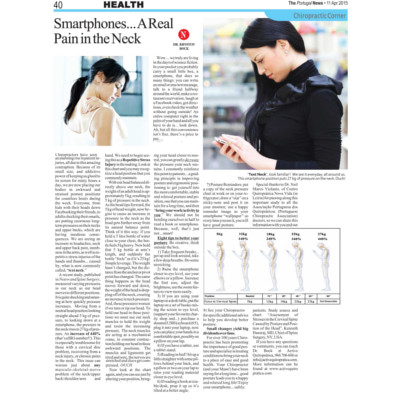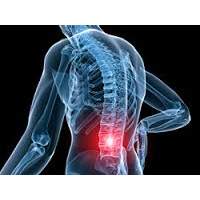Smartphones….A Real Pain in the Neck

Chiropractic Corner column, The Portugal News
(easy to read text below)
Wow…. we truly are living in the days of science fiction. In your pocket you probably carry a small little box, a smartphone, that does so many things: you can write an email or SMS/text message, talk to a friend half way around the world, make a restaurant reservation, laugh at a Facebook video, get directions, even check the weather without going outside! An entire computer right in the palm of your hand and all you have to do is… look down. Ah, but all this convenience isn’t free, there’s a price to pay….
Chiropractors have seen an alarming rise in patient injuries, all due to this amazing contraption. Because of its small size, and addictive power of keeping us glued to its screen for many hours a day, we are now placing our bodies in awkward and strained posture positions for countless hours during the week. Everyone, from kids with their heads down Facebooking their friends, to adults checking their emails, is putting enormous long-term pressures on our necks and upper backs, which are having insidious consequences. We are seeing an increase in headaches, neck and upper back pain, numbness in the arms, as well as repetitive stress injuries of the hands and thumbs… caused by, what is now commonly called, ”
text neck.”
 “Text Neck“, look familiar? We see it every day, all around us.
“Text Neck“, look familiar? We see it every day, all around us.
This smartphone position puts 27 kg of pressure on the neck. Ouch!
A recent study, published in Neuro and Spine Surgery, measured varying pressures in our neck as our head moves to different positions. It is quite shocking and amazing at how quickly pressure increases. Moving from a neutral head position looking straight ahead 5 kg of pressure, to looking down at a smartphone, the pressure in the neck rises to 27 kg of pressure. An increase of 440% (that’s a BIG number!!). This is especially troublesome for those with a cervical disc problem, recovering from a neck injury, or chronic pains in the neck. This issue can worsen just about any musculoskeletal-
Look at this chart and you may recognize a head position that you commonly maintain.

With our head balanced directly above our neck, the weight of an adult head is approximately 5 kg, resulting in 5 kg of pressure in the neck. As the head tips forward, the 5 kg of head weight, now begins to cause an increase in pressure in the neck as the head gets further away from its natural balance point. Think of it this way: if you hold a 5 liter bottle of water close to your chest, the bottle feels 5 kg heavy. Now hold that 5 kg bottle at arm’s length, and suddenly the bottle “feels” as if it’s 25 kg! Simple leverage. The weight hasn’t changed, but the distance from the anchor or pivot point has changed. Same thing happens as the head moves forward and down, the weight of the head is dropping off of the neck, creating an increase in neck pressure. And, these pressures worsen if we turn or tip our head. To hold our head in these positions we must use our neck muscles to hold the weight and resist the increasing pressure. The neck muscles are acting as a mechanical crane, in constant contraction holding our head in these awkward positions. The muscles and ligaments get tired and sore, the nerves are stretched and discs get compressed. OUCH!
Now look at the chart again, and you can see just by altering your position, bringing your head closer to neutral, you can greatly decrease the pressure your neck sustains. I constantly reinforce this point to patients… a guiding principle in improving posture and ergonomic positioning is: get yourself into the most comfortable, stable and relaxed posture and position, one that you can maintain for a long time, and then “bring your work/activity to you.” We should not be bending ourselves in half to read a book or smartphone. Because, well, that’s just not… smart!
Eight tips to better your posture. Be creative, think outside the box.
1) Take frequent breaks… get up and look around, take a few deep breaths. Do some stretching.
2) Raise the smartphone closer to eye level, use your elbows or a pillow. Increase the font size, adjust the brightness, use the zoom feature to view more easily.
3) If you are using your laptop on a desk/table, put the laptop on a set of books raising the screen to eye level, (support your favorite charity shop and…) purchase a donated USB keyboard (5 euros), plug it into your laptop, now you can place your hands in a comfortable spot, possibly on a pillow on your lap.
4) If you have a tablet, use a tablet stand.
5) Reading in bed? Sit up a little straighter with some pillows behind your back, and a pillow or two on your lap to raise your reading material closer to eye level.
6) If reading a book at a table/desk, prop it up so it’s tilted at a better angle.
7) Posture Reminders: put a copy of the neck pressure chart at work or on your refrigerator; draw a “star” on a sticky note and post it on your monitor; use a happy reminder image as your smartphone “wallpaper” so every time you use it, you will have good posture.
8) See your Chiropractor for specific additional advice to help you develop better posture.
Small changes yield big dividends over time.
For over 100 years Chiropractic has been promoting the importance of good posture and specialize in treating conditions to bring your neck to a place of ease and good health. Your Chiropractor (and your Mum!) have been saying for a long time… good posture leads you to a happy and relaxed long life! Enjoy your smartphone… safely.
Study source and chart: “Assessment of Stresses in the Cervical Spine Caused by Posture and Position of the Head”, Kenneth Hansraj, MD, Chief of Spine Surgery, NY, USA.
Please call today for an appointment!
(+351) 282 352 202 (click and call)
282 352 202


